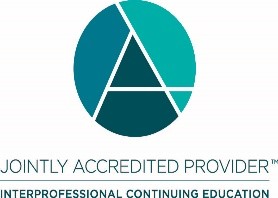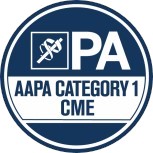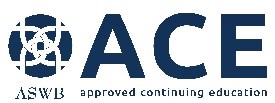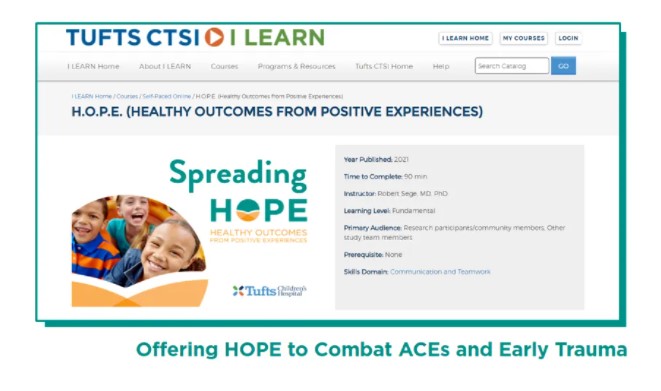The HOPE team has launched an online course titled “H.O.P.E. (Healthy Outcomes From Positive Experiences)”!
Provided through the Tufts Learning Management System platform and developed in collaboration with the Education Development Center, this self-paced course offers free access to comprehensive research, based in the “Science of the Positive,” on how Positive Childhood Experiences drive healthy development and can mitigate the effects of Adverse Childhood Experiences.
Through interactive modules, featuring short videos, interviews with guest experts, short quizzes, and supplemental materials, you will learn what Adverse and Positive Childhood Experiences are, how they affect adult health, and how to incorporate a HOPE-informed approach to working with children, families, and communities.
The course presents background information on the health effects of adverse childhood experiences (ACEs) and the research showing how key positive childhood experiences (PCEs) prevent and mitigate the effects of ACEs and toxic stress resulting in improved health outcomes. The biologic mechanisms of how PCEs affect the brain are presented. Different themes of HOPE implementation are explored, including how to use the HOPE framework to address racial and socioeconomic disparities at your organization. Upon successful completion of the course the learner will have a solid understanding of PCEs and HOPE and will be ready to begin to incorporate the framework of HOPE into their work with families.
Target Audience
This activity is intended for physicians, physician assistants, nurses, psychologists and social workers engaged in the care of adolescent/pediatric patients.
Educational Objectives
After completing this activity, the participant should be better able to:
- Discuss how key positive childhood experiences prevent and mitigate the effects of ACEs.
- Explain the 4 building blocks of HOPE.
- Explain the difference between Type 1 and Type 2 thinking.
- Develop an understanding of how to incorporate HOPE into work with children and families.
Faculty/Contributors
Robert Sege, MD, PhD
Professor of Medicine and Pediatrics
Tufts Medical Center
Dina Burstein, MD, MPH
Assistant Professor of Medicine
Tufts Medical Center
Chloe Yang, BS
Research Assistant
Tufts Medical Center
Loren McCullough, BA
Research Assistant
Tufts Medical Center
Baraka Floyd, MD
Clinical Assistant Professor of Pediatrics
Stanford University School of Medicine
Ronald Ferguson, PhD
Adjunct Lecturer in Public Policy
Harvard Kennedy School
Annika Linkenbach
Student
University of Montana
Danielle Laraque-Arena, MD
Senior Scholar-in-Residence
The New York Academy of Medicine
Heather Forkey, MD
Associate Professor
University of Massachusetts Medical School
Moira A. Szilagyi, MD, PhD
Professor of Pediatrics
UCLA School of Medicine
Kanwaljeet S. Anand, MBBS, D.Phil.
Professor of Pediatrics
Stanford University School of Medicine
Gail Guillard
Training Director
Maryland Family Network
Arianna Guillard
Assistant
Maryland Family Network
Ciara Floyd
Lecturer
University of Texas, San Antonio
Disclosure of Conflicts of Interest
Postgraduate Institute for Medicine (PIM) requires faculty, planners, and others in control of educational content to disclose all their financial relationships with ineligible companies. All identified conflicts of interest (COI) are thoroughly vetted and mitigated according to PIM policy. PIM is committed to providing its learners with high quality accredited continuing education activities and related materials that promote improvements or quality in healthcare and not a specific proprietary business interest of an ineligible company.
The faculty/contributors reported the following relevant financial relationships with ineligible entities related to the educational content of this CE activity:
Robert Sege, MD, PhD
Royalties from UpToDate
Dina Burstein, MD, MPH
Ms. Burstein has nothing to disclose.
Chloe Yang, BS
Ms. Yang has nothing to disclose.
Loren McCullough, BA
Ms. McCullough has nothing to disclose.
Baraka Floyd, MD
Dr. Floyd has nothing to disclose.
Ronald Ferguson, PhD
Consulting fees from Thermo Fisher Scientific
Annika Linkenbach
Ms. Linkenbach has nothing to disclose.
Danielle Laraque-Arena, MD
Dr. Laraque-Arena has nothing to disclose.
Heather Forkey, MD
Ownership Interest less than 5% in Precision Optics Corporation
Moira A. Szilagyi, MD, PhD
Stipend from UpToDate
Stipend from AAP for serving as AAP President-elect
Kanwaljeet S. Anand, MBBS, D.Phil.
Dr. Anand has nothing to disclose.
Gail Guillard
Ms. Guillard has nothing to disclose.
Arianna Guillard
Ms. Guillard has nothing to disclose.
Ciara Floyd
Ms. Floyd has nothing to disclose.
The PIM Planners and others have nothing to disclose. The Tufts Medical Center planners and others have nothing to disclose, other than Dr. Sege, as noted below:
Robert Sege, MD, PhD
Royalties from UpToDate

Joint Accreditation Statement
In support of improving patient care, this activity has been planned and implemented by the Postgraduate Institute for Medicine and Tufts Medical Center. Postgraduate Institute for Medicine is jointly accredited by the Accreditation Council for Continuing Medical Education (ACCME), the Accreditation Council for Pharmacy Education (ACPE), and the American Nurses Credentialing Center (ANCC), to provide continuing education for the healthcare team.
Physician Continuing Medical Education
The Postgraduate Institute for Medicine designates this enduring material for a maximum of 1.5 AMA PRA Category 1 Credit(s)™. Physicians should claim only the credit commensurate with the extent of their participation in the activity.
Continuing Nursing Education
The maximum number of hours awarded for this Continuing Nursing Education activity is 1.5 contact hours.
Continuing Psychologist Education
Continuing Education (CE) credits for psychologists are provided through the co-sponsorship of the American Psychological Association (APA) Office of Continuing Education in Psychology (CEP). The APA CEP Office maintains responsibility for the content of the programs.
Credit Designation:
This program offers 1.5 continuing education credits for psychologists.

Continuing Physician Assistant Education
Postgraduate Institute for Medicine has been authorized by the American Academy of PAs (AAPA) to award AAPA Category 1 CME credit for activities planned in accordance with AAPA CME Criteria. This activity is designated for 1.5 AAPA Category 1 CME credits. Approval is valid until June 14, 2022. PAs should only claim credit commensurate with the extent of their participation.

Continuing Social Work Education
As a Jointly Accredited Organization, Postgraduate Institute for Medicine is approved to offer social work continuing education by the Association of Social Work Boards (ASWB) Approved Continuing Education (ACE) program. Organizations, not individual courses, are approved under this program. State and provincial regulatory boards have the final authority to determine whether an individual course may be accepted for continuing education credit. Postgraduate Institute for Medicine maintains responsibility for this course. Social workers completing this course receive 1.5 Clinical continuing education credits.
Disclosure of Unlabeled Use
This educational activity may contain discussion of published and/or investigational uses of agents that are not indicated by the FDA. The planners of this activity do not recommend the use of any agent outside of the labeled indications. The opinions expressed in the educational activity are those of the faculty and do not necessarily represent the views of the planners. Please refer to the official prescribing information for each product for discussion of approved indications, contraindications, and warnings.
Disclaimer
Participants have an implied responsibility to use the newly acquired information to enhance patient outcomes and their own professional development. The information presented in this activity is not meant to serve as a guideline for patient management. Any procedures, medications, or other courses of diagnosis or treatment discussed or suggested in this activity should not be used by clinicians without evaluation of their patient’s conditions and possible contraindications and/or dangers in use, review of any applicable manufacturer’s product information, and comparison with recommendations of other authorities.



